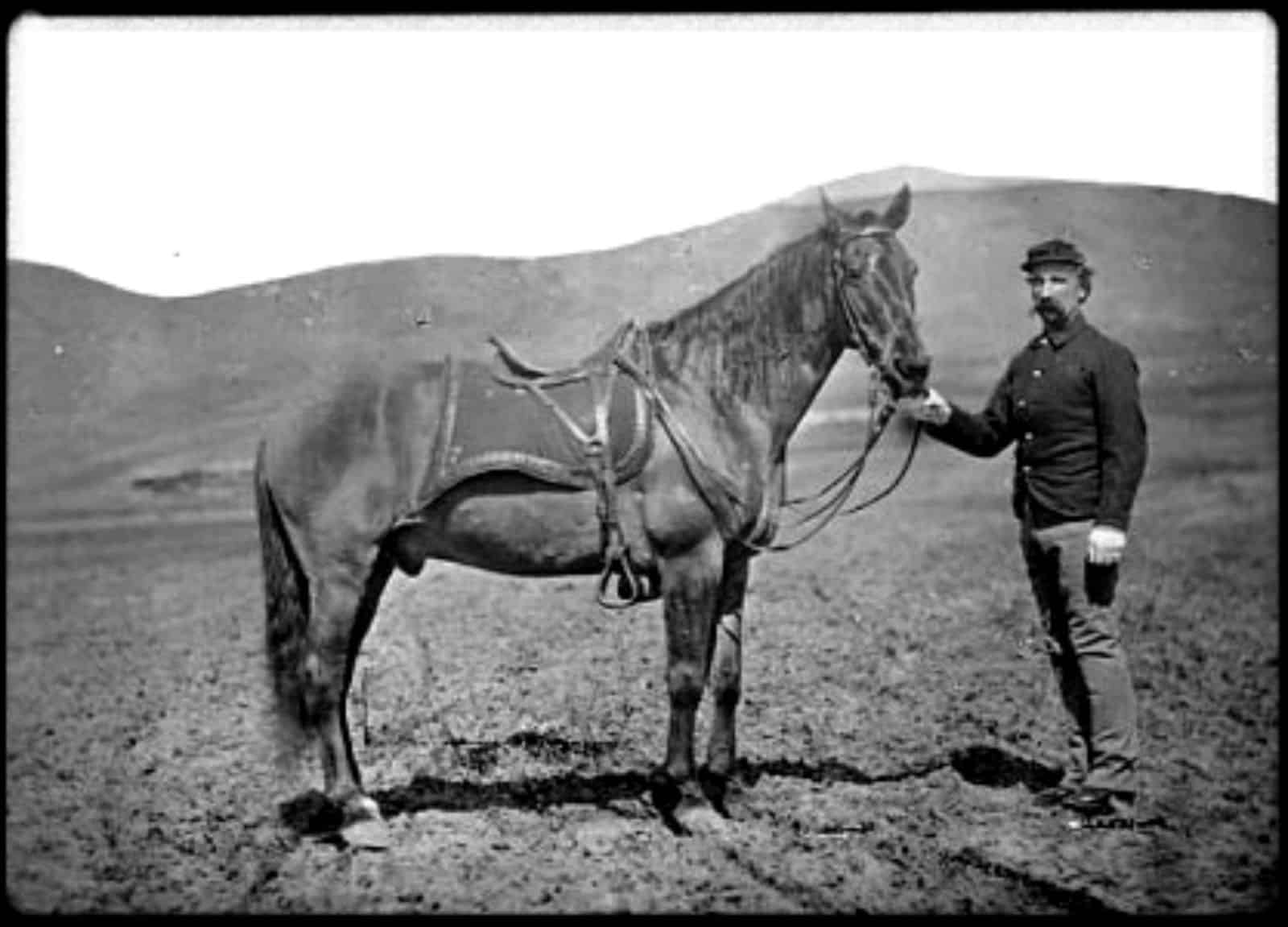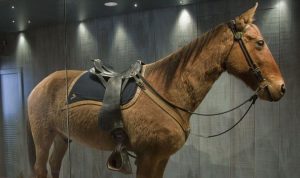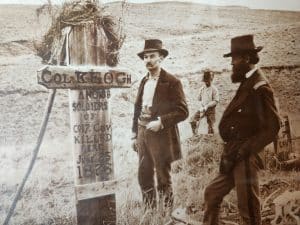ADS

Comanche and soldier [Photo: public domain]
From a stable in Dakota Territory to a fateful day in southern Montana Territory, Comanche became one of the best-known horses in history. Comanche was the personal mount of Capt. Myles Keough of the 7th Cavalry regiment stationed at Fort Abraham Lincoln south of Mandan.
Severely wounded, Comanche was found clinging to life on the field where two days earlier five companies of Lt. Col. George Armstrong Custer’s command were slain at the Battle of the Little Bighorn on June 25, 1876. Recognizing the significance of the moment, soldiers did everything possible to ensure Comanche survived. Remarkably, Comanche recovered from seven grievous wounds, including a bullet that crashed through Keough’s knee and into the side of his prized mount.
Comanche became a living symbol of bravery, toughness, and determination for the United States Army. The famous horse would never be ridden again per order of Col. Samuel Sturgis, 7th Cavalry:
Headquarters Seventh United States Cavalry, Fort A. Lincoln, D. T., April 10th, 1878. General Orders No. 7.
(1.) The horse known as ‘Comanche,’ being the only living representative of the bloody tragedy of the Little Big Horn, June 25th, 1876, his kind treatment and comfort shall be a matter of special pride and solicitude on the part of every member of the Seventh Cavalry to the end that his life be preserved to the utmost limit. Wounded and scarred as he is, his very existence speaks in terms more eloquent than words, of the desperate struggle against overwhelming numbers of the hopeless conflict and the heroic manner in which all went down on that fatal day.
(2.) The commanding officer of Company I will see that a special and comfortable stable is fitted up for him, and he will not be ridden by any person whatsoever, under any circumstances, nor will he be put to any kind of work.
(3.) Hereafter, upon all occasions of ceremony of mounted regimental formation, ‘Comanche,’ saddled, bridled, and draped in mourning, and led by a mounted trooper of Company I, will be paraded with the regiment.

Comanche on display at University of Kansas Natural History Museum [Photo: public domain]
Comanche was already the most famous horse at Fort Abraham Lincoln by the time Sturgis issued his order. However, the issuance of the order further elevated Comanche’s status well beyond the U.S. Army. Comanche’s trail in history is interesting.
The horse was purchased by the U.S. Army in St. Louis, Missouri in 1868. The breeding and age of Comanche was not recorded, but Keough liked the horse so much that he selected and purchased the animal for his personal mount. Later that same year Keough rode the bay into a battle with Comanche warriors in Kansas, a fight in which the horse was struck with an arrow but never faltered. It was after that skirmish that Keough named his mount “Comanche”.
It took more than a year for Comanche to recover from his wounds received in the Little Bighorn fight. He was cared for in the Fort Lincoln stables by farrier John Rivers. Rivers was present when a Bismarck Tribune reporter visited the fort to learn more about Comanche.
“He was found in a ravine where he had crawled, there to die. He was raised up and tenderly cared for. His wounds were serious, but not necessarily fatal if properly looked after… He carries seven scars from as many bullet wounds. There are four back of the foreshoulder, one through a hoof, and one on either hind leg. Comanche is not a great horse, physically talking; he is of medium size, neatly put up, but quite noble looking. He is very gentle. His color is ‘claybank’.”
Four bullets were removed from Comanche’s body, with the final surgery happening in April of 1877, nearly a year after the battle. Comanche was taken to Fort Meade, near present-day Rapid City, South Dakota, in the summer of 1879. In 1887 Comanche was moved again, this time to Fort Riley, Kansas. There he was honored with the rank of “Second Commanding Officer” by the 7th Cavalry.
Comanche was believed to be about 29 years old when he passed away in 1891. The famous horse was given a full military funeral, one of only four in history to receive such an honor. Comanche was not interred but instead was sent to the University of Kansas for preservation. His taxidermy mount remains for public viewing at that university.

Cpt. Sanderson at Keough’s reburial [Photo: public domain]
Capt. Myles Keough
The Irishman Keough is an example of the “immigrant army” image in Dakota Territory. Originally recruited from Europe to help lead Union troops in the U.S. Civil War, Keough had a reputation for gallantry that he earned on two continents.
As a second lieutenant in Italy during the Papal War of 1860 his forces were surrounded, and he was captured. He was released shortly thereafter in a prisoner exchange. Keough resigned in 1862 and was soon on a steamer bound for America. He was given the rank of captain upon enlistment in the Union Army. Among his notable moments in the Civil War was riding alongside Gen. John Buford at the battle of Gettysburg.
Following the war Keough remained in the U.S. Army, eventually as captain of Company I, dubbed the “Wild I”, of the 7th Cavalry. He was well liked by his men. His body was found on the Little Bighorn Battlefield among several soldiers of Company I.
